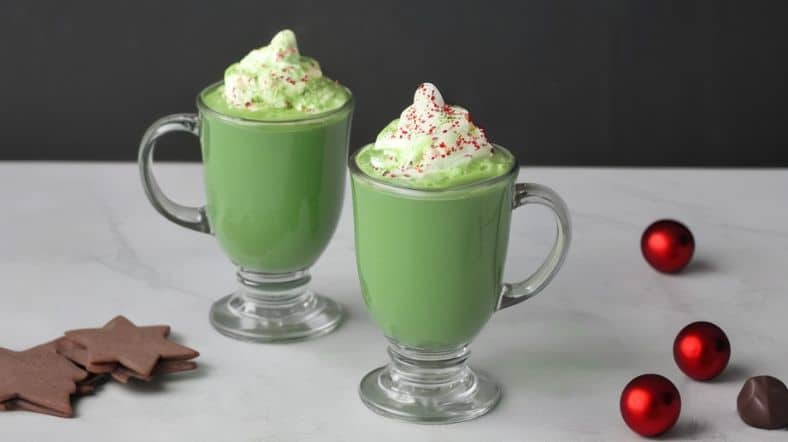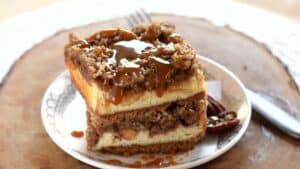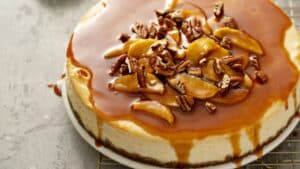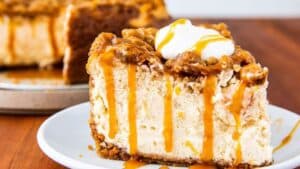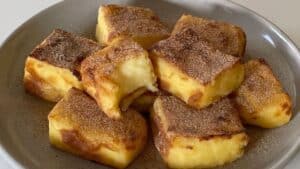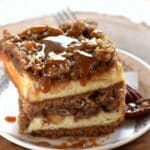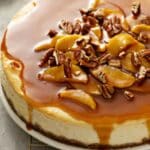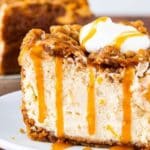You’ve seen the memes. The fuzzy green guy with a heart two sizes too small, plotting in his mountain cave. But what if I told you that same mischievous Grinch could crash your Christmas dessert party — not to ruin it, but to elevate it? That’s where Grinch Green Hot Chocolate strolls in. It ain’t just cute. It’s clever, nostalgic, and downright indulgent. And if you’re planning a holiday dessert spread that turns heads and fills cups, you’re gonna want this oddball green cocoa front and center.
Grinch Green Hot Chocolate isn’t some TikTok trend that fizzles out faster than cheap marshmallows. It’s a modern holiday classic with serious crowd-pulling charm. Kids lose their minds over it. Adults—well, they smirk, sip, then go back for seconds. And if you’re running a bakery, café, or catering gig, offering it can turn your December sales graph into a candy cane mountain range.
Why Green?
Let’s start with the obvious. Hot chocolate, by its very nature, is brown. Green ain’t natural. And that’s the hook.
Color psychology isn’t just something marketers mumble about in boardrooms. It matters. Especially around food. Green in desserts is rare, unexpected. It signals whimsy, fantasy, play. It screams Dr. Seuss without saying a word. The vibrant hue taps into childhood memories faster than you can say “Whoville.” And that’s the magic. You’re not just selling cocoa. You’re selling a feeling.
Now let’s talk about execution. Because a bad green cocoa is worse than lukewarm gas station hot chocolate. If you don’t nail the texture, the taste, the look—you’re toast. Burnt toast.
Building the Base: The Cocoa Mix That Matters
Let’s talk structure, then jazz. First, the base recipe.
You want your cocoa thick. Not quite pudding, but not that watery stuff that slides around like dishwater. Think French-style chocolat chaud meets American diner nostalgia.
Here’s a foundational Grinch cocoa base:
- Whole milk — Don’t go low-fat. Don’t go skim. You want full fat for that rich mouthfeel.
- White chocolate chips — Go high-end here. Valrhona, Guittard, or Callebaut if you can.
- Vanilla bean paste — Real beans. No extract fakery.
- Sea salt — Just a whisper, to offset the sweetness and deepen flavor.
Once your white base is silky and glossy, that’s when the green hits. Gel-based food coloring (never liquid—it messes with the texture). AmeriColor “Electric Green” is the gold standard. One drop too many and it looks like antifreeze. Too little, and it’s barely lime sherbet.
Test. Tweak. Taste. Color-matching is key. You want Grinch skin, not slime or mint toothpaste.
Toppings Make the Magic
You could stop at the cocoa, but you’d be missing the point.
Grinch Green Hot Chocolate lives and dies by the toppings. It’s not just a drink—it’s a dessert in a mug. Maybe even a dessert buffet centerpiece if you play your cards right.
Start with:
- Whipped cream — Piped high and swirly. Freshly whipped, not from a can. Sweetened lightly with powdered sugar and stabilized with mascarpone or gelatin if you’re prepping ahead.
- Red heart sprinkle — One single candy heart dead-center. A nod to the Grinch’s heart “growing three sizes.” It’s kitschy. It’s iconic.
- Crushed peppermint or green sanding sugar — Adds texture. Adds sparkle. Adds crunch.
You can go extra with:
- Mini green marshmallows (homemade if you’re ambitious)
- White chocolate shavings
- Gold dust for a glam twist (hey, even Grinches like bling)
The Party Context: Plating, Presentation, and Profit
Now here’s where professionals lean in. Because it ain’t just about taste. It’s about experience. About Instagram. About viral shareability.
At a dessert party—especially a themed one—your Grinch Green Hot Chocolate should own the stage. Don’t serve it in paper cups, unless you hate joy.
Use clear glass mugs or mini dessert jars. Layer colored mini marshmallows at the bottom. Let the green cocoa pour in slowly over them. Watch the color swirl. That’s theater, not just food.
For plated service, pair with red velvet cake bites, candy cane shortbread, or even pistachio macarons. Match colors. Contrast textures. Think like an artist, plate like a rebel.
Add a DIY station if it’s buffet-style. Guests get their mug, then build their Grinch with toppings. You provide the base. They go nuts. You get credit.
From a business angle? Grinch cocoa costs about $0.85–$1.20 to make per serving (assuming high-quality ingredients). You can sell it for $4.50 to $6.50 depending on venue. That’s a healthy margin, folks. Especially in December, when people spend like elves on espresso.
The Science Behind the Sip
Want to get nerdy? Let’s do it.
White chocolate isn’t technically chocolate (no cocoa solids), but it’s a fantastic flavor vehicle. It melts at 86°F–90°F, coating the palate with creamy, milky sweetness. That makes it ideal for fat-soluble color infusions like gel-based dyes.
The fat content in whole milk (~3.25%) and heavy cream (~36%) provides a silky texture and slows flavor release. That’s why sips of Grinch cocoa linger. They bloom slowly. It’s luxurious.
And adding salt? Not just a flavor booster. It actually reduces the perception of bitterness and enhances sweetness via ion channels on the tongue. That’s culinary chemistry in a cup.
Addressing the Doubters: Is It Too Gimmicky?
Every trend gets side-eye. Is this just a gimmick? Something that’ll look silly in five years?
Probably. But that doesn’t mean it ain’t valuable now.
Seasonal offerings like this aren’t about permanence. They’re about relevance. Emotional triggers. Memorable experiences. In December, people want tradition with a twist. Grinch cocoa gives them both.
And let’s not forget: “gimmick” often means “differentiator” in food biz speak.
Variations for Pros
If you’re an executive pastry chef, mixologist, or culinary director, here are a few pro-level spins:
Matcha Grinch Hot Chocolate
Use ceremonial-grade matcha whisked into white chocolate ganache. You get a natural green tone and a grassy complexity that appeals to adult palates.
Frozen Grinch Cocoa
Think frappé-style. Blend cooled white hot chocolate with crushed ice, mint syrup, and green coloring. Top with whipped cream and a cherry. Serve in hurricane glasses for flair.
Spiked Grinch Cocoa
Add peppermint schnapps, crème de menthe, or vanilla vodka. Boozy. Balanced. Be careful with quantities—white chocolate can get cloying fast with sweet liqueurs.
Vegan Version
Use oat milk (extra creamy), vegan white chocolate (harder to source but doable), and coconut whipped topping. Stabilize with aquafaba if you need structure.
Common Pitfalls
Too much coloring – Makes it taste artificial and look radioactive.
Overheating white chocolate – It seizes quickly. Keep it low and slow.
Over-sweetening – White chocolate is already high-sugar. Don’t add more unless you’re offsetting with acid (e.g. berry coulis) or bitterness (e.g. espresso shots).
Poor ingredient sourcing – People can taste the difference. Skimping on quality will bite you. Hard.
Data & Trends
According to Google Trends, searches for “Grinch hot chocolate” spike every December, with steady growth since 2018. Pinterest pins for “Grinch party desserts” rose 33% year-over-year in Q4 2023. And TikTok videos under #GrinchHotChocolate have over 40 million combined views as of late 2024.
Restaurants and cafes that offered holiday-themed cocoa flights reported a 28% increase in beverage sales in December vs. November (source: QSR Magazine 2023 Holiday Report).
This isn’t a trend you wanna miss. It’s a low-cost, high-impact menu item with massive visual appeal.
Final Stir: Takeaways for the Pros
Grinch Green Hot Chocolate is more than a cute seasonal drink. It’s a smart strategy.
It’s a branding tool. A memory-maker. A differentiator in a holiday market saturated with sameness.
It taps nostalgia. Delivers delight. And when done right, it becomes your seasonal signature.
So experiment. Play. Own it.
Your dessert party—or café menu—deserves a little mischief.
